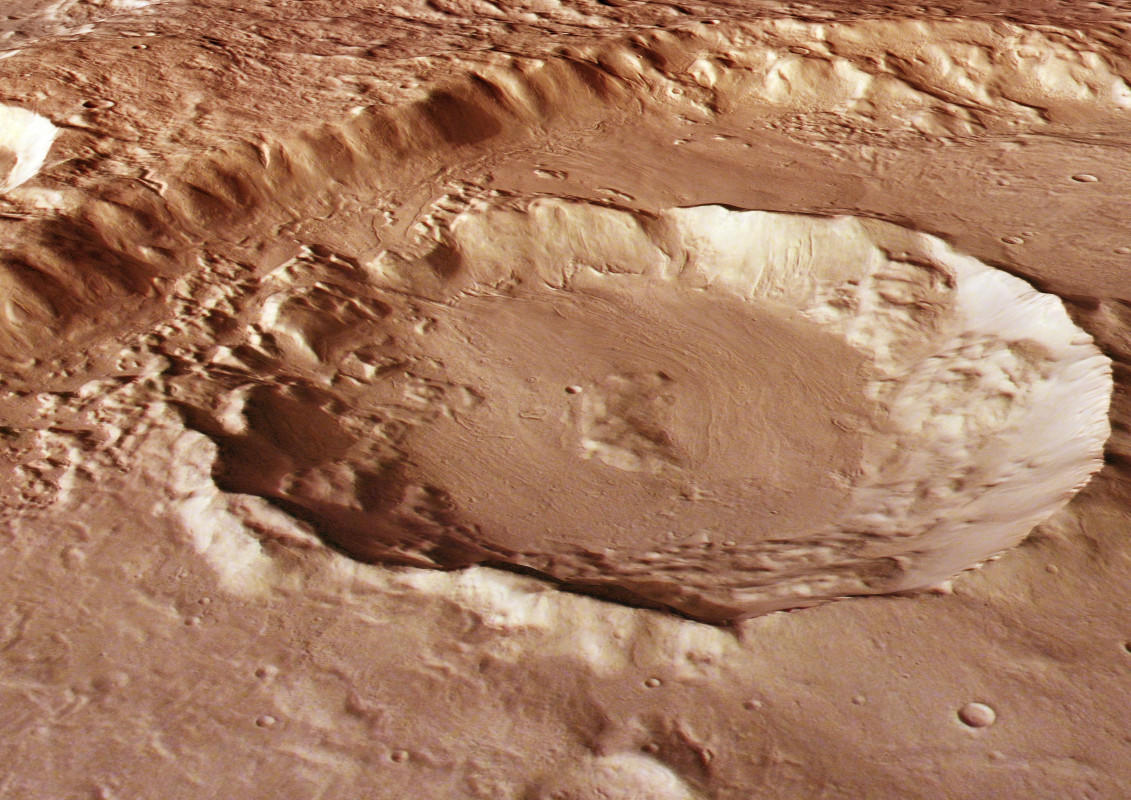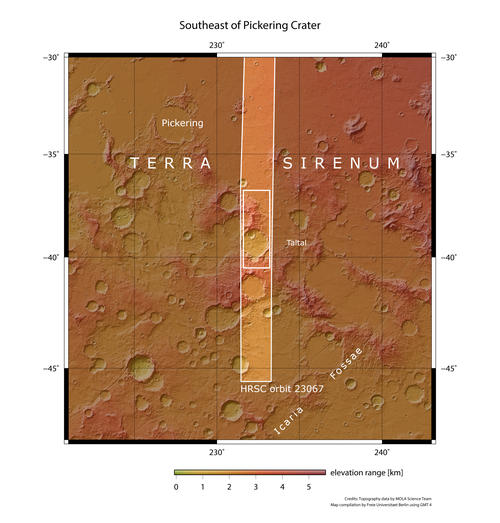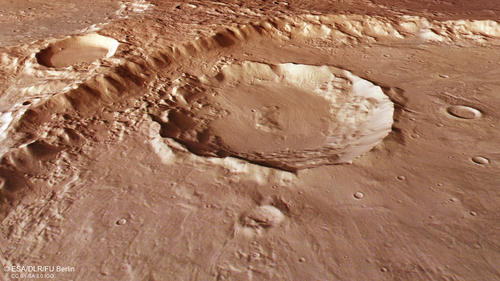Department of Earth Sciences
Service Navigation
Southeast of Pickering Crater – complex history in one shot
Image data, taken by the High Resolution Stereo Camera (HRSC) on board ESA’s Mars Express mission show a very diverse region created by multiple processes southeast of Pickering Crater. HRSC is a camera experiment that was developed and is operated by the German Aerospace Center (Deutsches Zentrum für Luft- und Raumfahrt; DLR).
» read more below the gallery
Southeast of Pickering Crater • Position & 3D view
Southeast of Pickering - context map
Image Credit: MOLA Science Team/FU Berlin
Southeast of Pickering Crater - 3D
Image Credit: ESA/DLR/FU Berlin
Southeast of Pickering Crater • HRSC images
Southeast of Pickering Crater - HRSC color-coded terrain model
Image Credit: ESA/DLR/FU Berlin
Southeast of Pickering Crater - HRSC color image
Image Credit: ESA/DLR/FU Berlin
Southeast of Pickering Crater - HRSC anaglyph
Image Credit: ESA/DLR/FU Berlin
Southeast of Pickering Crater - HRSC annotated
Image Credit: ESA/DLR/FU Berlin
Southeast of Pickering Crater
» read more about the diverse region
The region presented in this HRSC observation is located in Terra Sirenum at the border to Daedalia Planum. A wide morphologic diversity created by multiple processes can be observed within one picture. The points of interest are marked in the annotated image. At the left side of the image, a large valley with a width of up to 1.8 km can be spotted. It could have transported meltwaters into the adjacent basin. Stretching in the same southwest-northeast direction and cutting through the basin, a large fracture can be observed, located just 10 km north of the valley. These large channel-like fractures are called Graben and are created in regions of extensional tectonic stress where the bedrock is faulted and pulled apart. At the surface, linear sections drop downward along paired, parallel faults. These graben features show the same orientation like the Icaria Fossae, located southeast (see overview map).
The large, image filling, ancient impact crater measures about 70 km in diameter and partly shows a dark-toned region, possibly caused by dark wind-blown sands. The floor of the crater is very flat and shows an interesting wind eroded surface in the eastern (lower) part. These erosional features are called Yardangs. A smaller impact crater, measuring up to 20 km in diameter is located in the northern (right) part of the large crater. It shows an interesting ejecta layer that could indicate an impact into a water/ice bearing surface. Inside the smaller crater and also in close vicinity to the north and also in small craters around, a smooth-looking material is observed, displaying a surface morphology resembling terrestrial ice/debris glaciers (marked with “lobate crater fill” and “filled crater” in the annotated image). Theses flow structures are formed when a mixture of debris and ice from a glacier flows downhill and the debris then trace the movements of the plastic ice flow.
A very different appearance is shown by the next ancient impact crater further to the north and marked as “lava filled crater” in the annotated image. Here, the morphology rather suggests a lava infill or cover of the impact crater floor. Also, none of the periglacial features present in the large crater can be found. Neighboring further north, a large field of dendritic valleys can be found. These valleys are believed to have formed relatively early in Martian history by atmospheric precipitation (rain or snow).
Finally, a large lava field is located in the lower right section of the image. Here, wrinkle ridges can be found. These features are created when tectonic forces compress a lava sheet that is still soft and elastic. The steeper side of the wrinkle ridges mark the front of the ridge where the material buckled up and over the subsequent lava sheet. All these different landforms demonstrate the complex history and evolution of Mars within a single image.
High Resolution Stereo Camera (HRSC)
» information to image origin and processing
The images were acquired by the HRSC (High Resolution Stereo Camera) on 5 April 2022 during Mars Express Orbit 23067. The ground resolution is approximately 15 meters per pixel and the images are centered at about 232° East and 38° South. The color image was created using data from the nadir channel, the field of view which is aligned perpendicular to the surface of Mars, and the color channels of the HRSC. The anaglyph image, which creates a three-dimensional impression of the landscape when viewed with red/blue or red/green glasses, was derived from the nadir channel and one stereo channel. The oblique perspective view was generated from the digital terrain model, the nadir and color channels of HRSC. The color-coded topographic view is based on a digital terrain model (DTM) of the region, from which the topography of the landscape can be derived. The reference body for the HRSC-DTM is a Mars equipotential surface (Areoid).
HRSC is a camera experiment that was developed and is operated by the German Aerospace Center (Deutsches Zentrum für Luft- und Raumfahrt; DLR).The systematic processing of the camera data took place at the DLR Institute for Planetary Research in Berlin-Adlershof. The working group of Planetary Science and Remote Sensing at Freie Universität Berlin used the data to create the image products shown here.
To download released raw images and DTMs of the region in GIS-ready formats, follow this link to the mapserver.
Images: ESA/DLR/FU Berlin, CC BY-SA 3.0 IGO
Copyright Notice:
Where expressly stated, images are licenced under the Creative Commons Attribution-ShareAlike 3.0 IGO (CC BY-SA 3.0 IGO) licence. The user is allowed to reproduce, distribute, adapt, translate and publicly perform it, without explicit permission, provided that the content is accompanied by an acknowledgement that the source is credited as 'ESA/DLR/FU Berlin', a direct link to the licence text is provided and that it is clearly indicated if changes were made to the original content. Adaptation / translation / derivatives must be distributed under the same licence terms as this publication.
The High Resolution Stereo Camera was developed at the German Aerospace Center (DLR) and built in collaboration with partners in industry (EADS Astrium, Lewicki Microelectronic GmbH and Jena-Optronik GmbH). The science team, which is headed by Principal Investigator (PI) Dr. Thomas Roatsch, consists of 52 co-investigators from 34 institutions and 11 countries. The camera is operated by the DLR Institute of Planetary Research in Berlin-Adlershof.






